
| Part of a series on |
| Jainism |
|---|
 |
Kharatara Gaccha is one of Shvetambara Murtipujaka Gacchas. It is also called the Vidhisangha (the Assembly) or Vidhimarga (Path of Proper Conduct), as they regard their practices as scripturally correct. [1] [2] [3]

| Part of a series on |
| Jainism |
|---|
 |
Kharatara Gaccha is one of Shvetambara Murtipujaka Gacchas. It is also called the Vidhisangha (the Assembly) or Vidhimarga (Path of Proper Conduct), as they regard their practices as scripturally correct. [1] [2] [3]
Kharatara Gaccha was founded by Vardhamana Sūri [2] (till 1031 CE). His pupil, Jineshvara, got honorary title 'Kharatara' (Sharp witted or Fierce) because he defeated Suracharya, leader of Chaityavasis in public debate in 1024 CE at Anahilvada Patan. So the Gaccha also got his title. [2] Khartara also means that "which is beyond" (tara) "purity" (khara), that is, being upright with the absolute truth, by following the religious scriptures without deviation (Jain Agamas) as it is. Another tradition regards Jinadatta Suri (1075―1154) as a founder of Gaccha. [2] [4]
Jinavallabha realised the difference between texts and words of teachers and put emphasis on sacred texts in Kharatara doctrine in the eleventh century. He wrote the Crown of Assembly. [1]
The following four are known as Dada Guru in the sect and are venerated as spiritual guides. [5]
Kharatara ascetics regard their practices as scripturally correct. They follow basic Shvetambara canon and works of other Kharatara teachers. [1]
Ascetics: 193 nuns, 19 monks in 1986 [1] or 50-75 monks and 300 nuns. [2] Large number of its lay followers reside in Rajasthan and West Bengal states of India. [2] [1]
Several members of Kharatara Gaccha were notable writers:
Jainism, also known as Jain Dharma, is an Indian religion. Jainism traces its spiritual ideas and history through the succession of twenty-four tirthankaras, with the first in the current time cycle being Rishabhadeva, whom the tradition holds to have lived millions of years ago, the twenty-third tirthankara Parshvanatha, whom historians date to the 9th century BCE, and the twenty-fourth tirthankara Mahavira, around 600 BCE. Jainism is considered an eternal dharma with the tirthankaras guiding every time cycle of the cosmology. The three main pillars of Jainism are ahiṃsā (non-violence), anekāntavāda (non-absolutism), and aparigraha (asceticism).

Samprati was the 5th Emperor of the Maurya empire. He was the son of 3rd Mauryan Emperor Ashoka's son, Kunala, and succeeded his cousin, 4th Mauryan Emperor Dasharatha, as emperor of the Maurya Empire. He built 1,50,000 Jain Derasars and made 1,50,00,000 Jain idols. Also he was believed to have taken an oath to dig foundation of a new Jinalaya everyday and then only he used to do navakrashi.
Aacharya Haribhadra Suri was a Svetambara mendicant Jain leader, philosopher, doxographer, and author. There are multiple contradictory dates assigned to his birth. According to tradition, he lived c. 459–529 CE. However, in 1919, a Jain monk named Jinvijay pointed out that given his familiarity with Dharmakirti, a more likely choice would be sometime after 650. In his writings, Haribhadra identifies himself as a student of Jinabhadra and Jinadatta of the Vidyadhara Kula. There are several, somewhat contradictory, accounts of his life. He wrote several books on Yoga, such as the Yogadṛṣṭisamuccaya and on comparative religion, outlining and analyzing the theories of Hindus, Buddhists and Jains.

Sthānakavāsī is a sect of Śvetāmbara Jainism which was created in medieval era. The Sthanakvasi, whose name refers to the sect’s preference for performing religious duties at a secular place such as a monks’ meetinghouse (sthanak) rather than at a temple, is different from the Murtipujaka sect in that it rejects idolatry. It believes that idol worship is not essential in the path of soul purification and attainment of Nirvana/Moksha. Sthānakavāsī accept thirty-two of the Jain Agamas, the Śvetāmbara canon, contending that the scriptures make no mention of idol worship and temples. According to the sect, Mahavira himself never endorsed idol worship, and they argue that such practices were borrowed from other religions by the Murtipujaka Jains.
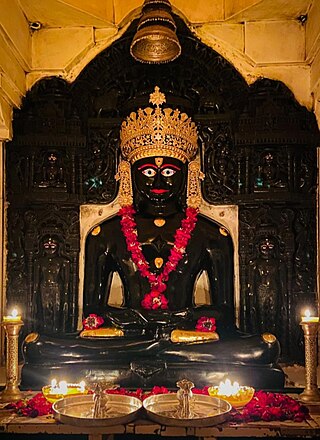
Neminātha, also known as Nemi and Ariṣṭanemi, is the twenty-second Tīrthaṅkara of Jainism in the present age. Neminatha lived 81,000 years before the 23rd Tirthankara Parshvanatha. According to traditional accounts, he was born to King Samudravijaya and Queen Shivadevi of the Yadu dynasty in the north Indian city of Sauripura. His birth date was the fifth day of Shravana Shukla of the Jain calendar. Krishna, who was the 9th and last Jain Vasudev, was his first cousin.
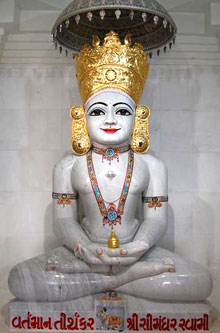
Mūrtipūjaka, also known as Derāvāsī ("temple-dweller") or Mandir Mārgī, is the largest sect of Śvetāmbara Jainism. Mūrtipūjaka Jains differ from both Śvetāmbara Sthānakavāsī and Śvetāmbara Terāpanthī Jains in that they worship images of the Tīrthaṅkaras. Mūrtipūjaka may also generally describe members of both the Śvetāmbara and Digambara traditions who use idols (mūrti) in their worship (pūjā).
Tapa Gaccha is the largest Gaccha of Svetambara Jainism.

A Dādābāḍī is a type of shrine, usually located near a Jain temple, and dedicated to one of the four Dādā Gurus revered by the Kharatara Gaccha sect of the Svetambara Jains. The most notable shrines are in Ajmer, Malpura and Mehrauli. The four Dādā Gurus are Jinadatta Sūri, Jinachandra Sūri Maṇidhārī, Jinakuśala Sūri and Jinachandra Sūri II.
Jainism is a religion founded in ancient India. Jains trace their history through twenty-four tirthankara and revere Rishabhanatha as the first tirthankara. The last two tirthankara, the 23rd tirthankara Parshvanatha and the 24th tirthankara Mahavira are considered historical figures. According to Jain texts, the 22nd tirthankara Neminatha lived about 5,000 years ago and was the cousin of Krishna.
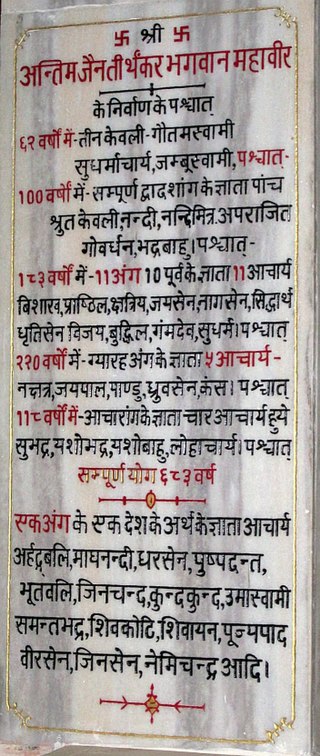
A Pattavali, Sthaviravali or Theravali, is a record of a spiritual lineage of heads of monastic orders. They are thus spiritual genealogies. It is generally presumed that two successive names are teacher and pupil. The term is applicable for all Indian religions, but is generally used for Jain monastic orders.
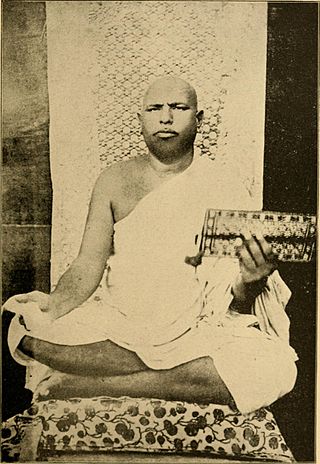
Acharya Vijayanand Suri, also known as Atmaramji of Gujranwala, was the first Swetambar Murtipujaka Jain monk in modern times to receive the title of Acharya. Born and raised in Punjab, he was initiated as a Sthanakvasi monk and later joined the Murtipujaka tradition. He travelled extensively in Gujarat, Rajputana and Punjab; he organised and reformed Jain community, ascetic orders and literature. He wrote several books in Hindi and was invited to the first World Parliament of Religions in 1893 which was attended by Virchand Gandhi later.

Jainism is an Indian religion which is traditionally believed to be propagated by twenty-four spiritual teachers known as tirthankara. Broadly, Jainism is divided into two major schools of thought, Digambara and Śvetāmbara. These are further divided into different sub-sects and traditions. While there are differences in practices, the core philosophy and main principles of each sect is the same.
Acharya Prem Suri was a Jain Svetambar Murtipujaka Acharya. He belonged to the Tapa Gaccha sub-sect of the religion. After his death, his tradition was divided into two; led by Ramachandra Suri Maharaj Saheb and Bhuvanbhanu Suri Maharaj Saheb respectively. Ramchandra Suri continued to follow the calendar as his guru
Jainism and Hinduism are two ancient Indian religions. There are some similarities and differences between the two religions. Temples, gods, rituals, fasts and other religious components of Jainism are different from those of Hinduism.
Gaccha, alternatively spelled as Gachchha, is a monastic order, along with lay followers, of the image worshipping Murtipujaka Svetambara sect of Jainism. The term is also used in the Digambara sect.

Vividha Tirtha Kalpa is a widely cited Jain text composed by Jinaprabha Suri in the 14th century CE. It is a compilation of about 60 Kalpas (sections), most of them give the accounts of major Jain Tirthas.
Prabandha is a literary genre of medieval Indian Sanskrit literature. The prabandhas contain semi-historical anecdotes about the lives of famous persons. They were written primarily by Jain scholars of western India from 13th century onwards. The prabandhas feature colloquial Sanskrit with vernacular expressions, and contain elements of folklore.
The Nābhi-nandana-jinoddhāra-prabandha is a 1336 Sanskrit book in the prabandha genre written by the Jain scholar Kakka Suri (Kakkasūri). The main objective of the book is to record the renovation of the Rishabhanatha Jain temple on Shatrunjaya hill in Gujarat, during the Delhi Sultanate rule. The work also provides other information, such as a history of the author's spiritual lineage (gaccha) and a description of the Delhi Sultan Alauddin Khalji's military conquests.
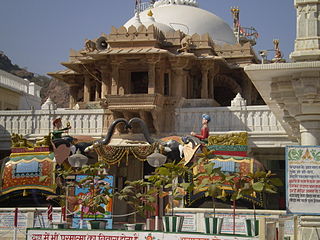
Nakodaji Tirth is a major Jain tirth in the Indian state of Rajasthan, located between the villages of Vikrampura and Nakoda in Barmer District. The temple houses the icon of Nakoda Bhairava, a popular Shvetambara guardian deity.
Udaya-prabha Sūri was a Jain monk and writer from the Vaghela kingdom of present-day India. He was a member of the literary circle of the minister Vastupala, and wrote several Sanskrit-language works.